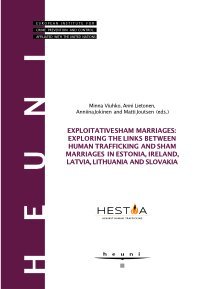By Anniina Jokinen, Anna-Greta Pekkarinen, Jessiina Rantanen
Forced marriage is a multifaceted phenomenon encompassing sev - eral intersecting factors that relate to situations in which individu - als are compelled to marry or stay married against their will. Forced marriage is widely recognized as a violation of human rights and in particular as a form of gender-based violence and honour-based vio - lence. The harms and negative consequences of forced marriages are multifold and challenge many service providers as well as the crimi - nal justice system. This report outlines the concrete challenges, factors and con - cepts that must be addressed when developing effective responses to tackle forced marriages and providing support to victims and persons affected. It is targeted towards various professionals and practitioners who may encounter victims of forced marriage or persons, families or communities affected by the phenomenon in their line of work. The content is based on a desk review of academic and other relevant liter - ature, as well information collected by the EASY project partners: the European Institute for Crime Prevention and Control, affiliated with the United Nations (HEUNI), University of Lleida (Spain), Associació Valentes I Acompanyades (Spain), SOLWODI (Germany), and the Im - migrant Council of Ireland, to identify approaches that have relevance in the development of effective and victim-centred interventions for victims of forced marriages. The best practices were collected mainly via semi-structured (individual or group) interviews with experts and/or survivors, that were based on a shared interview framework. The interviews were conducted in the summer and autumn of 2023.1 The experts interviewed included, e.g., NGO representatives and counsellors working with topics related to forced marriage, migrant women’s rights, honor-based violence and human trafficking, shelter/residential counsellors, government officials and policymakers, and law enforcement authorities from Finland, Germany, Ireland, and Catalonia (Spain). The survivors interviewed included, e.g., victim-survivors who work as mentors and/or had been supported by the interviewing organisation. Throughout the report there are quotes from the interviews to demonstrate the challenges, experiences and solutions identified. Table 1. Number of persons interviewed to collect best practices by each country and in total. The best practices collected were also shared and discussed with partners in a best practice workshop hosted by SOLWODI in Bonn, Germany on 20–21 November 2023. Each partner identified 4–8 best practices with a focus on themes such as proactive methods to identify victims, engaging with persons from impacted communities and reducing the risk of forced marriage; ways to support and assist victims; training and awareness-raising activities targeting professionals; multi-agency collaboration at local, national and international levels; and municipal, regional or national strategies to tackle or address honor-related violence and/or forced marriages. Ten of the collected best practices were selected and summarised for this publication. Moreover, in early 2024, the EASY project partners launched a legislative overview which presents the results of comparative desk research on the legal approach to forced marriage in Germany, Finland, Ireland and Spain (Villacampa and Salat 2023). Therefore, this report does not cover legislative frameworks and procedures in place in the four countries to address forced marriages and to protect the victims as they are covered in detail in the legislative overview. The two reports are complimentary. The ultimate aim of the EASY project is to enhance support for victims/survivors of forced marriage and strengthen the work against forced marriage in the four partner countries.
Helsinki: European Institute for Crime Prevention and Control, affiliated with the United Nations (HEUNI) HEUNI, 2024. 58p.






